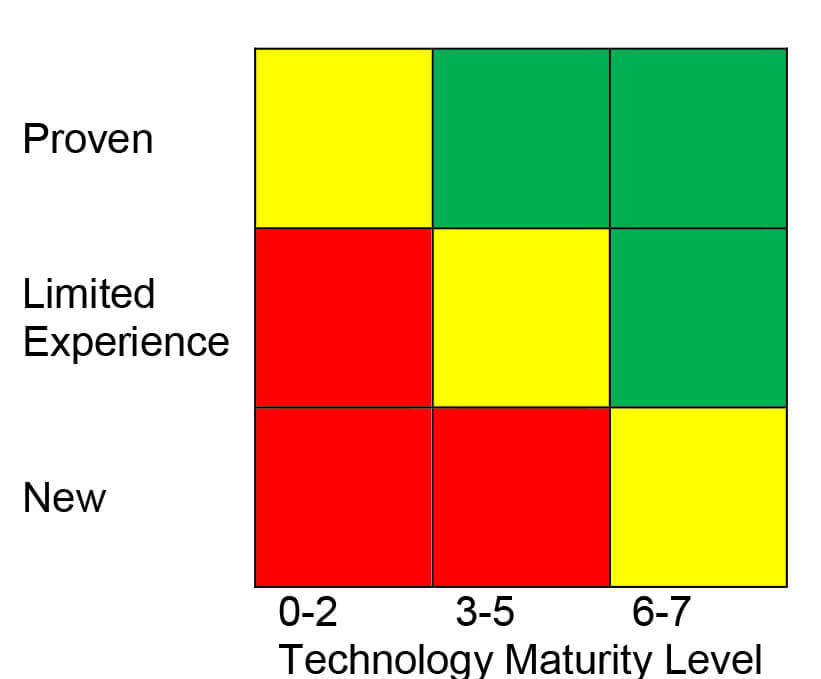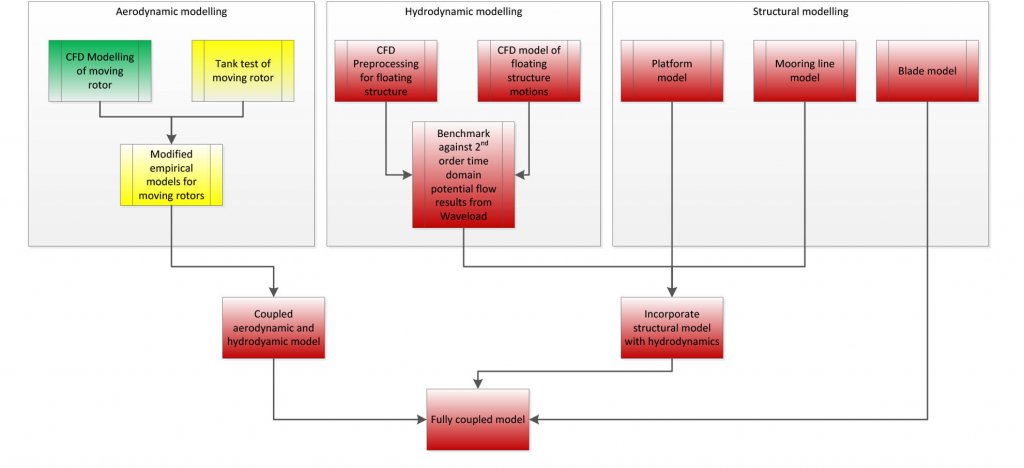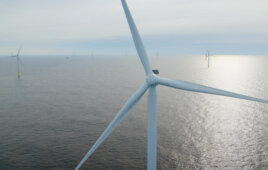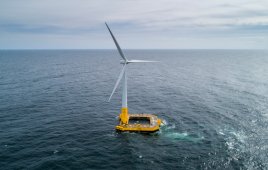By Ross Wigg; Vice President Renewables
Lloyd’s Register Energy
As the global offshore wind industry increases, so does the pressure to, attract private investment, contribute to a stable electrical grid, and reduce dependence on feed-in tariffs. These often result in conflicting goals to cut costs (which requires innovation) and reduce risks (which tends to rely on proven products).

Technology assessment risk matrix. It is common for new technologies to rely on a small number of novel components, or a new combination of existing components or systems — but not every new component will require Technology Qualification. In the visual representation risk assessment, red indicates that a Technology Qualification is definitely required, yellow suggests a potentially good idea, and green means it isn’t necessary.
Although conventional offshore wind turbines have garnered much attention of late in the United States, especially with construction of the Block Island Wind Farm off the shores of Rhode Island, floating offshore wind is also emerging as interest to investors and developers. A floating wind turbine lets a mounted turbine generate electricity in water depths where bottom-mounted towers are not feasible.
According to a recent report published by the UK’s Energy Technologies Institute, floating offshore wind has cost benefits and could deliver a levelized cost of energy that makes it competitive with some of the lowest-cost forms of available energy generation.
But how does one achieve a commercially attractive cost of energy for floating wind without compromising risk? Researchers have begun by testing projects to determine their viability.
WindFloat Pacific is an innovative pilot project currently planned off the coast of Oregon to demonstrate the potential of floating wind turbines to provide clean energy from deep water. WindFloat Pacific will represent the first commercial floating offshore wind farm anywhere in the world with commissioning anticipated by the end of 2017.
The European Commission also recently granted approval for the development of a 25-MW floating wind farm demonstration project off the coast of Portugal.
These aren’t the first floating wind projects. Wind-development company, Statoil, had the world’s first demonstration project back in 2009 and intends to build world’s first utility-scale floating wind farm, Hywind Scotland (as verified by six years of successful prototype operation). This floating wind farm will begin production in 2017 and is expected to power about 20,000 homes.
One issue common to newer devices and developments, however, is performance validity and certification — which are important for attracting investors. In some countries, for example, it’s still unnecessary to perform third-party certification of offshore wind farms. But in France and the UK, it is almost unheard of to develop wind farms without consultation with a certification body. Certification can mitigate performance claims and assure investors that new projects are deployed in a risk-responsible manner.
The risks
Ideally, certification of new technology should rely on existing codes and standards to limit the number of uncertainties. But often it takes time for new standards to fully develop and only after experience with several designs and years of operation.
Technology Qualification is a new risk-reduction process designed to help mitigate the uncertainty associated with new devices and, in this case, new offshore platforms. It is a qualification process against which novel platforms are certified based on existing relevant design standards and technology that is generic to all floating or offshore wind systems.
For example, it is possible to design a floating offshore turbine, which conforms to design rules given in existing standards (such as IEC 61400-3 [5] and the ISO 19900 series of standards) for offshore structures. But the action of the wind turbine in combination with the floating platform causes loading where there aren’t sufficient experience or available guidelines.
Even if a platform design consists of no new components, the novel way in which they’re constructed or interact with the environment can open the product to risks. Technology Qualification essentially serves as a bridge, providing a means of independent assurance for new developments.
The process
Technology Qualification must begin with a specific definition of the device or platform technology and what it is designed to achieve. The goals may be defined in terms of structural reliability for a given design lifetime or relate to power production, availability, reliability.

Combined Technology Qualification & project certification process
The Technology Assessment process results in a list of Critical Technology Elements for qualification. After the Technology Qualification process, a third-party review should follow to provide product assurance to the project’s stakeholders.
For example, one of the key areas of research for floating wind turbines is the effect motion has on the rotor aerodynamics, and the consequential effect on power capture and structural loading. Technology Qualification can provide a roadmap on how a fully coupled simulation model is developed for a floating turbine while outlining and linking it to the existing qualification of a range of floating wind concepts.
In this first step, the product is decomposed from a component and a global functionality viewpoint to determine the list of requirements for which each device or aspect of the technology is responsible. This results in a list of “Critical Technology Elements” upon which the remainder of the process is based.
The subcomponents and functions outlined in the decomposition will result in a list of items that can be designed according to established practices, codes, and standards, as well as items that call for additional efforts to determine the required level of testing or quality control measures. At this early stage, a simple ranking is performed depending on the stage of each aspect. The ranking is based on the “Technology Maturity Levels,” which describes how well tested a component is in isolation.
The Technology Maturity levels are modified to account for the level of experience of the interface between components, known as the “Integration Maturity Levels.” These levels are then combined with the level of experience of the function or subcomponent in the proposed operating environment to classify the product’s risk.
At this point, a variety of risk-assessment methods can take place, such as Hazard Identification, Structured What-if Technique, Functional Hazard Assessment, Failure Modes, and potentially others. The risks are ranked according to the severity and the probability of occurrence. Once performed, the acceptance criteria for the risk are determined by agreeing on appropriate safety margins and mitigation actions.
The critical elements
The Technology Assessment process results in a list of Critical Technology Elements. Although not every element will need to go through the qualification process, it’s critical to ensure novel materials and components meet the most relevant standards possible.
For example, consider the following elements:
- Materials. When materials are novel or have not been used in maritime environments, appropriate design requirements may be lacking. In this case, the qualification activities could include additional testing, perhaps to simulate accelerated aging, strength, or redundancy such that the device doesn’t suffer catastrophic failure.
- Components. For new components in the drivetrain or power takeoff system, a range of different methods can qualify the Critical Technology Element, including:
– Adding redundancy to critical stages identified in the FMECA (FMEA — or failure mode, effects, and criticality analysis — is a common inductive analytical method performed at the functional or piece-part level of a component)
– Adding condition-monitoring systems to identify failures at an early stage
– Specifying additional design margins to account for larger uncertainties
– Conducting additional component testing
– Performing additional design studies to explore the effects of design uncertainties
– Defining design load cases to account for possible failures, and
– Tailoring inspections to ensure component conditions. - Control systems. Though existing design standards for wind turbines rely on many years of experience with traditional PI-based control algorithms, control algorithms for floating turbines may differ substantially. Specific examples of qualification activities for loads analysis include:- Exploration of additional load cases to give confidence that off-design conditions do not cause abnormal control behavior
– Sensitivity analysis covering inputs such as signal noise, actuator response, and control parameter variation, and
– Tank testing with control hardware in the loop. - Platform concepts. While the offshore oil and gas industry has explored a wide range of different platform concepts, the design requirements of floating offshore wind may result in modified concepts. Analysis of new and existing designs should occur to ensure an ideal platform.
The load
Loading on floating wind turbines is an area where the fields of wind-turbine rotor dynamics and floating offshore structure design overlap. There are conflicts between the modeling assumptions and validity of theories used for each. One critical area is the simulation length, which is restricted to 10-minute histories in rotor design to account for the stationary turbulence spectrum over this time period.

Developing an aerodynamic floating turbine model
Lloyd’s Register is conducting research that will benchmark the aerodynamic loading of floating wind turbines to model. The process for developing a fully coupled floating turbine model is presented here (green represents the completed packages, yellow are those in-progress, and the red packages have not yet started).
It’s worth noting that Lloyd’s Register is currently conducting research that will benchmark the aerodynamic loading of floating turbines and integrate this into a related model. The intent is to understand the coupling between aerodynamic, hydrodynamic, and structural loading from the rotor, support structure, and station-keeping system, so as to reduce model uncertainties.
The final stage of this aerodynamic modeling aims to generate improved empirical models that will allow assessing the aerodynamic effects of floating wind systems over a much larger range of simulated conditions.
The certification
The Technology Qualification plan also serves to outline what tasks a developer will take to mitigate the risks identified from the failure modes so the product fully meets its goals.
After execution of the Technology Qualification plan, it’s important to review and certify the results to ensure the activities outlined meet a quality level consistent with what is required in the field. This can be done by an independent design review or parallel calculations.
A third-party review is commonly carried out to provide assurance to the project stakeholders.
Filed Under: Offshore wind




